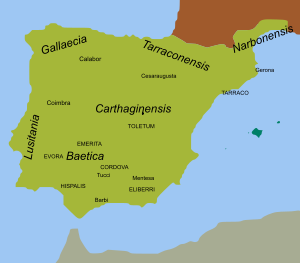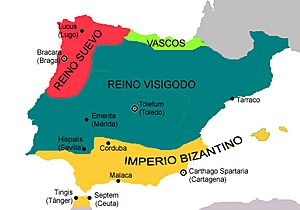Ingund (wife of Hermenegild) facts for kids
Quick facts for kids Ingund |
|
|---|---|
| Queen consort of the Visigoths | |
| Born | 567/568 Metz |
| Died | c. 585 |
| Spouse | Hermenegild |
| House | Merovingian |
| Father | Sigebert I |
| Mother | Brunhilda of Hispania |
| Religion | Catholic |
Ingund, born around 567 or 568, was the oldest child of Sigebert I, who was the King of Austrasia. Her mother was Brunhilda, whose father was King Athanagild of the Visigoths. Ingund married Hermenegild and became the first Catholic queen of the Visigoths.
Contents
Ingund's Early Life
Ingund's father, Sigebert, became the ruler of the Frankish kingdom of Austrasia in 561. This happened after his own father, Chlothar I, passed away.
Ingund was likely named after her grandmother, following a common tradition of that time. She had two younger siblings: a sister named Chlodosind, born around 569, and a brother named Childebert, born in 570.
In 575, King Sigebert was involved in a conflict with his half-brother, Chilperic I, who was the King of Neustria. Just as Sigebert was close to winning, he was attacked and killed. After Sigebert's death, Brunhilda and her children were in great danger. Childebert, who was only five years old, was especially at risk from Chilperic. A leader named Duke Gundovald quickly went to Paris, where Brunhilda and the children were living. He took Childebert and made sure he was safe with the nobles of Austrasia. When Chilperic arrived in Paris, he captured Brunhilda. He then ordered Ingund and Chlodosind to be held in a monastery in Meaux. Ingund would have been only seven or eight years old during this very difficult time.
Marriage to Hermenegild
In 569, Leovigild became a co-ruler of the Visigoths in Hispania (modern-day Spain) and Septimania (a region in Gaul). To strengthen his position as king, he later married Goiswintha. She was the widow of the previous Visigothic King Athanagild and was also Ingund's grandmother. Leovigild had two sons from an earlier marriage: Hermenegild and Reccared. Around 578, Leovigild arranged for his oldest son, Hermenegild, to marry Ingund. At this time, Ingund's mother, Brunhilda, was acting as a regent, or temporary ruler, for her young son Childebert.
Ingund traveled from France to Toledo in Spain. Her journey took her through Septimania, a part of Gaul that the Visigoths still controlled. This area stretches from the Pyrenees mountains along the Mediterranean coast. As Ingund passed through the Visigothic town of Agde, she met a local Catholic bishop named Phronimius. He warned her not to accept the 'poison' of Arianism, which was a different Christian belief.
In 579, Prince Hermenegild married Ingund. He followed the Arian faith, while she was Catholic. At first, Queen Goiswintha welcomed Ingund warmly. However, the queen was determined that Ingund should be re-baptized into the Arian faith. Ingund, who was still only twelve years old, strongly refused. According to a historian named Gregory of Tours, the Queen became very angry. She treated Ingund harshly and insisted she be put into a baptismal pool. Perhaps because of this conflict, or more likely because King Leovigild wanted to secure his sons' future as rulers, he sent Hermenegild and Ingund to Seville. They were to rule a part of his kingdom, likely the regions of Baetica and southern Lusitania.
Hermenegild's Revolt
In Seville, Ingund met Leander, a Catholic monk. Leander came from an important and powerful family in Spain. His two brothers later became bishops, and his sister became an abbess, a leader of a group of nuns. Most people in southern Spain were Catholic. Also, many Visigoth nobles were Catholic. Leander was either already the bishop of Seville when Hermenegild and Ingund arrived, or he became bishop soon after. There is no doubt that the bishop had great influence. He likely saw Ingund, a Catholic princess, as a chance to help the Catholic cause. History shows many examples of queens influencing their husbands' religious choices.
Hermenegild's region of Baetica was next to Spania, which included cities in southeastern Spain controlled by the Byzantine Empire. These cities were mostly Latin Christian.
During the 500s, many Catholic religious leaders moved to southern Spain. Many came from Africa, but also from other areas. This movement was often due to difficult times and religious disagreements. Examples of these new arrivals include Nanctus and Donatus from Africa, and a Greek named Paul. So, when Hermenegild and Ingund arrived in Seville, they would have found a strong and active Catholic community.
In the winter of 579–580, Hermenegild declared himself king in Seville. However, he still referred to his father as 'King'. We don't know if Hermenegild believed in the Catholic faith at this time. It wasn't until 582 that he officially accepted the Catholic faith. But from the beginning, he seemed to have the support of those who favored the Catholic cause. By 580, Leander had already traveled to Constantinople to ask for help from the Byzantine Empire for the rebels.
Sometime between 580 and 582, Hermenegild and Ingund had a son. They named him Athanagild, after Ingund's great-grandfather, King Athanagild.
What Happened Next
According to Gregory of Tours, Ingund's strong faith greatly influenced her husband, Hermenegild, to become Catholic. One reason people believe his conversion was sincere and not just for political reasons is that when Hermenegild had to choose between denying his Catholic faith and being executed, he chose to remain Catholic. Hermenegild's revolt showed that the Arian faith was losing its power in Spain.
Soon after Hermenegild and Ingund passed away, King Leovigild also died. He was succeeded by Reccared, Hermenegild's younger brother. Within two years of becoming king, Reccared embraced Catholicism. He then began the important work of uniting the Spanish people under one religion. It is believed that Ingund's spirit and Hermenegild's example had a lasting impact on Spanish society, especially on the new king, Reccared. Reccared did not support his father's actions against Hermenegild. He also punished the person who executed his brother, which shows the strong bond between the two brothers. Pope Gregory's words further confirm Hermenegild's influence: "Reccared, following not his faithless father but his martyr brother, was converted from the perverseness of the Arian heresy."
Family Connections
According to the Chronicle of Alfonso III, written in the 800s, Erwig was the son of Ardabast. Ardabast had traveled from the Byzantine Empire to Spain during the time of King Chindasuinth. He married Chindasuinth's niece, Goda. Ardabast was likely an Armenian or Persian Christian who had been exiled to Constantinople or Byzantine Africa. In Spain, he was made a count.
A Spanish family historian from the 1600s, Luis Bartolomé de Salazar y Castro, stated that Ardabast's father was Athanagild. This Athanagild was said to be the son of Saint Hermenegild and Ingund. His mother was supposedly Flavia Juliana, a daughter of Peter Augustus and a niece of the Emperor Maurice. However, this connection to the imperial family is questioned by historian Christian Settipani. He says that the only source for Athanagild's marriage to Flavia Julia is José Pellicer, whom he believes to be a forger.
See also
 In Spanish: Ingundis para niños
In Spanish: Ingundis para niños



